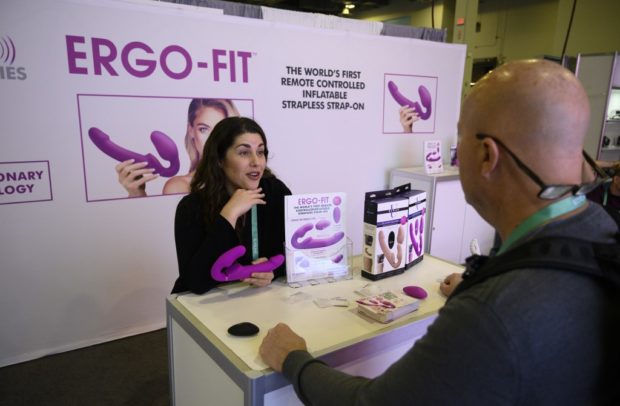Sex toy technology aims to rise above negative image

LAS VEGAS—Sex toys are for relaxation. For education. For healing after childbirth. For long-term or long-distance relationships. For women’s emancipation. And also … for pleasure.
But manufacturers aiming for respectability tend to save this argument for last.
“Sex toys have an extremely negative connotation,” said Jerome Bensimon, president of Satisfyer. “So we’ve rebranded ourselves as a ‘sexual well-being company.’”
The company has gained attention for its pressure wave technology used for clitoral stimulation, and has plans to launch a smartphone app for controlling sex toys, in particular by using voice commands.
Testing the waters
At its booth at the Consumer Electronics Show (CES) in Las Vegas, vibrators and Ben Wa balls sit alongside minivibrators shaped like ice cream cones.
After some ups and downs, “sex tech” is testing the waters this year.
As recently as last year, the display likely would have been banned.
At the 2019 show, the Consumer Technology Association (CTA), which runs the expo, stripped the Ose massager of an award for innovation, saying it was disqualified for being “immoral,” “obscene” and “profane.”
After an uproar, the CTA reversed itself and returned the prize to Lora DiCarlo, the company that manufactures the Ose.
Sex toys “are consumer electronics just like any other but are not treated like that,” said Janet Lieberman-Lu, cofounder of Dame Products, which manufactures small devices for clitoral stimulation.
Given their widespread use, “sex toys are by definition mainstream … They’re more adopted than a lot of products at CES.”
Her company has taken New York City’s public transportation system to court, complaining that it allows advertisements for erectile dysfunction medications and ads that contain humorous references to sex but not for sex devices.
“When you say that male sexual function is healthy and necessary but vibrators for women are obscene, you’re saying that men are supposed to be able to have sex and women aren’t supposed to be able to enjoy it,” said Lieberman-Lu.
“That’s what leads to rape culture.”
Mission to educate
Entrepreneurs in this industry, many of whom started out in conventional consumer electronics, medicine or cosmetics, say pleasure and health go hand-in-hand.
Given that school textbooks only recently began including information on the shape and size of the clitoris, they say they are on a mission to educate the public.
It is often “much easier to talk about health than pure pleasure, which can involve fear of rejection,” said Soumyadip Rakshit, CEO of Mystery Vibe, which develops vibrators that deal with both erectile difficulties in men and postpartum vaginal scarring in women.
To open up, people often need a catalyst.
“Everyone is keen to talk about it but no one wants to be the first,” he said. “If someone does that for them, a company, an article, a doctor … it makes that so much easier.”
Elsewhere on the showroom floor, Gerard Escaler, chief marketing officer at Lovense, explains how a male “masturbator” works.
The tubular objects have internal sleeves and are pink when intended for straight users and translucent for gay users.
The Hong Kong-based company offers several internet apps for use in long-distance relations with a partner or with online erotic performers like “cam girls” who sell access to live web video.
Lovense also is developing a virtual reality game for the male sex toy with female characters. Visitors have to imagine the contents, however, since the imagery, even if artificial, is not allowed during the consumer expo.